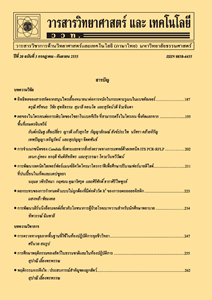Species Diversity of Wild Mushrooms and Influence of Some Environmental Factors on their Occurrence in Sakaerat Environmental Research Station, Nakhon Ratchasima Province
Main Article Content
Abstract
This study aimed to examine species diversity of wild mushrooms and the influence of environmental factors on the occurrence of them in dry dipterocarp forest (DDF) and dry evergreen forest (DEF) in Sakaerat Environmental Research Station, Nakhon Ratchasima province. In each forest type, a mushroom survey was conducted in 90 m x 90 m permanent plot, which was divided into 3 subplots with 30 x 90 m. Additionally, environmental factor data including air temperature, soil temperature, soil moisture content, crown cover, soil pH, soil texture, organic matter, macro element (C, P, Ca, Mg) were measured in the plots during September to November 2015. Results from surveys revealed 76 species, which were 71 identified mushroom species and 5 unidentified species. The identified species were classified in 39 genera 22 families 11 orders. Among of them, family Russulaceae had the highest in the number of species (10 species), followed by family Marasmiaceae (7 species). The diversity index in DDF (H’ = 2.67) was higher than DEF (H’ = 2.23). However, the similarity index of both forest types was low (SI = 11.17). Marasmiellus candidus (22.39 %) was the most abundant mushroom species in DDF, while Dicephalospora rufocornea (41.71 %) was the abundant species in DEF. The relationship between mushrooms in DDF and DEF with environmental factors analyzed by the ordination method with canonical correspondence analysis (CCA) can be divided into 4 groups, including (1) the group had positively related to the crown cover and available phosphorus, (2) the group had positively related to soil moisture, (3) the group had positively related to air temperature, soil temperature, light density, exchangeable Mg, exchangeable Ca, total carbon, soil organic matter, top soil pH, and (4) the group was generalist species.
Article Details
References
Hyde, K.D., Bahkali, A.H. and Moslem, M.A., 2010, Fungi an unusual source for cosmetic, Fungal Diver. 43: 1-9.
Tibuhwa, D.D., Muchane, M.N., Masiga, C.W., Mugoya, C. and Muchai, M., 2011, An inventory of macro-fungi and their diversity in the Serengeti-Masai Mara ecosystem, Tanzania and Kenya, Biol. Sci. 6: 399-410.
Hawksworth, D.L. and Lücking, R., 2017, Fungal diversity revisited: 2.2 to 3.8 million species, Microbiolspec. FUNK 52: 1-17.
Kerekes, J.F. and Desjardin, D.E., 2009, A monograph of the genera Crinipellis and Moniliophthora from Southeast Asia including a molecular phylogeny of the nrITS region, Fungal Diver. 37: 101-152.
Sangwanit, U., Suwanarit, P., Payuppanon, A., Leungsaart, J. and Sakolruk, B., 2013, List Biological Assets Mushrooms, Biodiversity-Based Economy Development Office, Bangkok. (in Thai)
Thongbai, B., Hyde, K.D., Chen, J. and Raspe, O., 2016, A new species and four new records of Amanita (Amanitaceae; Basidiomycota) from Northern Thailand, Phytotaxa 286: 211-231.
Chen, J., Zhao, R.L., Parra, L.A., Guelly, A.K., Kesel, A.D., Rapior, S., Hyde, K.D., Chukeati rote, E. and Callac, P., 2015, Agaricus section Brunneopicti: A phylogenetic reconstruction with descriptions of four new taxa, Phytotaxa 192: 145-168.
Suwannarach, N., Kumla, J. and Lumyong, S., 2015, A new whitish truffle, Tuber thailandicum from northern Thailand and its ectomycorrhizal association, Mycol. Prog. 14(83): 1-12.
Jang, S.K. and Hur, T.C., 2011, Relationship between climatic factors and the distribution of higher fungi in Byeonsanbando National Park, Korea, Mycobiology 42: 27-33.
Pinna, S., Gevry, M.F., Cote, M. and Sirois, L., 2011, Factor influencing fructification phenology of edible mushroom in a boreal mixed forest of Eastern Canada, Forest Ecol. Manag. 260: 294-301.
Duengkae, K., 2008, Relationships between Mushroom and Soil in Forest Ecosystems, Phetchabun Province, Research report, Department of National Parks, Wildlife and Plant Conservation, Bangkok. (in Thai)
Largent, L.D., 1973, How to Identify Mushrooms to Genus I: Macroscopic Features, Mad River Press, Inc., California.
Largent, L.D. and Watling, R., 1977, How to Identify Mushrooms to Genus IV: Key to Families and Genera, Mad River Press, Inc., California.
Pegler, D.N., 1986, Agaric Flora of Sri Lanka, 12th Ed., 104 Schwarzweiß-Tafeln, Royal Botanic Garden, Kew, 519 p.
Bergemann, S.E. and Largent, D.L., 2000, The site specific variables that correlate with the distribution of the Pacific Golden Chanterelle, Cantharellus formosus, Ecol. Manag. 130: 99-107.
Phillips, R., 2006, Mushroom, MacMillan Reference, Milan.
Hustad, V.P., Meiner, S.C. and Methven, A.S., 2011, Terrestrial macrofungi of Illinois Old-Growth Prairie Groves, Am. Midl. Nat. 166: 13-28.
Shanon, C.E. and Weaver, W., 1949, The Mathematical Theory of Communication, University of Illinois Press, Urbana.
Pushpa, H. and Purushothama, K.B., 2012, Biodiversity of mushrooms in and around Bangalore (Karnataka), India, J. Agric. Environ. Sci. 12: 750-759.
Kauseruda, H., Heegaardb, E., Büntgenc, U., Halvorsene, R., Eglic, S., Irletc, B.S., Greilhuberf, I.K., Dämonf, W., Sparksg, T., Nordéna, J., Høilanda, K., Kirkh, P., Semenovi, M., Boddyj, L. and Stensethk, N.C., 2012, Warming-induced shift in European mushroom fruiting phenology, PNAS. 109: 14488-14493.
Kosol, S.T., Kumlung, T., Inyod, P., Thongbai and Archavancom, T., 2005, Species Diversity of Edible Mushroom and Plants at Sakaerat Biosphere Reserve, Thailand Institute of Scientific and Technological Research, Bangkok. (in Thai)


